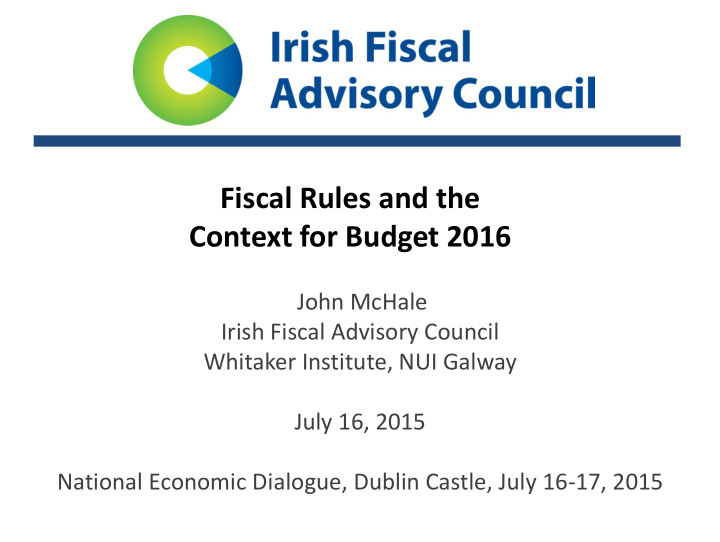



Fiscal Rules and the Context for Budget 2016 John McHale Irish Fiscal Advisory Council Whitaker Institute, NUI Galway July 16, 2015 National Economic Dialogue, Dublin Castle, July 16-17, 2015
Overview • The rationale for fiscal rules – Political economy – Economics • Overview of fiscal rules • Fiscal space in Budget 2016 given the rules
Value of a strong budgetary framework • European rationale – Spillovers across countries • Domestic rationale – Avoid pro-cyclicality in good times – Avoid large forced adjustments in bad times
Illustrative Debt Path (Min. Rule Compliance) General Government Debt Scenarios 140 120 Outturns 100 Scenario 80 % GDP 60 40 20 0 2000 2001 2002 2003 2004 2005 2006 2007 2008 2009 2010 2011 2012 2013 2014 2015 2016 2017 2018 2019 2020 2021 2022 2023 2024 2025 2026 2027 2028 2029 2030 Source: Department of Finance; internal IFAC calculations. Notes : Illustrative scenario assumes Department of Finance projections for 2016-2020 adjusted for minimum compliance with the Budgetary Rule; real GDP growth of 3% beyond 2020, with GDP deflator growth of 2% and marginal borrowing costs of 3.5%.
Complementary domestic and European elements Domestic ownership adds legitimacy to the European rules Effectiveness Effectiveness of Domestic of European Framework Framework Monitoring, peer pressure and possible sanctions of the European framework enhances the effectiveness of the domestic framework
European/Domestic fiscal rules European Domestic Corrective Arm Preventive Arm of SGP of SGP Domestic Budgetary Rule Consistent with Preventive Arm of SGP 1/20 th 3% Deficit MTO / Expenditure Domestic Domestic Rule Debt Rule Adjustment benchmark Expenditure Budgetary path to MTO Ceilings Rule Domestic Expenditure Ceilings Consistent with Expenditure Benchmark
Fiscal space under the rules • SPU/SES – Fiscal space of € 1.2 – € 1.5 billion • Projected change in the structural balance = 0.3 percent of GDP – Compares to a required change of 0.6 percent of GDP • Current estimate of fiscal space under full compliance with the adjustment path condition ≈ € 700 million
Domestic enforcement of the Budgetary Rule Fiscal Responsibility Act 2012 • 6 . — (1) If the Commission addresses a warning to the State under Article 6(2) of the 1997 surveillance and coordination Regulation or if the Government consider that there is a failure to comply with the budgetary rule which constitutes a significant deviation for the purposes of Article 6(3) of that Regulation, the Government shall, within 2 months, prepare and lay before Dáil Éireann a plan specifying what is required to be done for securing compliance with the budgetary rule. • 2. — (2) The official forecasts shall set out the data required to assess whether the . . . [Budgetary Rule] is complied with. • 1. — (1) “official forecasts” means the macroeconomic and budgetary forecasts published by the Department of Finance for the purposes of fiscal planning and known as the Spring forecasts and the Autumn forecasts . . .
EU Commission assessment of SPU • “Assuming a timely correction of the excessive deficit by 2015, Ireland would be subject to the preventive arm of the Stability and Growth Pact from 2016 onwards. Based on data presented in the programme, recalculated according to the commonly agreed methodology, progress towards the MTO is in line with the requirements of the preventive arm of the Pact. However, under the usual no-policy- change assumption, the Commission 2015 spring forecast, points to a risk of significant deviation from the required adjustment path. Hence, achieving the required structural targets hinges on the Irish government specifying and implementing measures necessary to achieve the budgetary target.” (European Commission, “Assessment of the 2015 Stability Programme for Ireland,” May 2015, p. 25.)
Some additional issues • Implications of strong exchequer returns over first half of 2015 – Should comfortably meet the 3 percent General Government deficit limit in 2015 – But limited implications for the change in the structural balance and allowable expenditure growth under the Expenditure Benchmark in 2016 • Clarification on the dual structural balance and EB requirements under the preventive arm of the SGP – Passing one with limited compliance on the other leads to an “overall assessment” – Importance of “fiscal effort” in that assessment • “Tax buoyancy” and the Expenditure Benchmark
Summing up • Political economy and economic rationales for the fiscal rules • Mutually reinforcing domestic and European elements • Current estimate of fiscal space for 2016 under the rules is ≈ € 700 million, but figure may be revised prior to Budget day
Recommend
More recommend